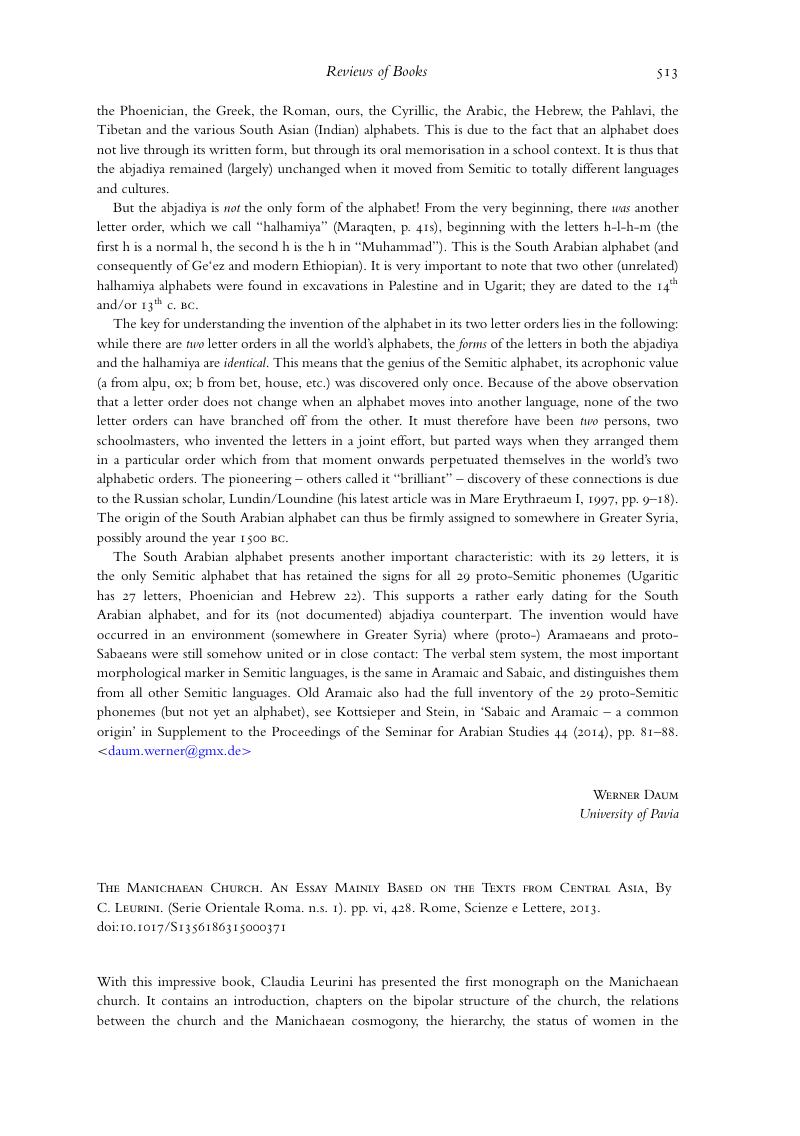No CrossRef data available.
Published online by Cambridge University Press: 20 August 2015

1 For ahlaw as loan word cf. Sundermann, W., Die Rede der Lebendigen Seele. Ein manichäischer Hymnenzyklus in mittelpersischer und soghdischer Sprache (Turnhout, 2012) (Berliner Turfantexte XXX), pp. 122fGoogle Scholar.
2 Cf. Colditz, I., “The Abstract of a Religion Or: What is Manichaeism?” In: Richter, R. G., Horton, Ch., Ohlhafer, K. (eds.), Mani in Dublin: Selected Papers from the Seventh International Conference of the International Association of Manichaean Studies in the Chester Beatty Library, Dublin, 8–12 September 2009, Leiden 2015 (Nag Hammadi and Manichaean Studies 88), pp. 47–70 Google Scholar.
3 Leurini takes it as a neologism, but cf. Parth. ammōzǎg and the very similar Phl. hammōzgār “teacher”.
4 Cf. Jones, S. F., “The Book of Elchasai in its Relevance for Manichaean Institutions with a supplement: The Book of Elchasai Reconstructed and translated.” ARAM 16 (2004), pp. 176–215 CrossRefGoogle Scholar.
5 Moriyasu, T. (Die Geschichte des uigurischen Manichäismus an der Seidenstraße. Forschungen zu manichäischen Quellen und ihrem geschichtlichen Hintergrund, (Wiesbaden, 2004) [Studies in Oriental Religions 50], p. 41 points to a close relation of the Manichaean monasteries to the subsistence strategy of Buddhist monasteriesGoogle Scholar.
6 Mayrhofer, M., Etymologisches Wörterbuch des Altindoarischen. 3 Vol. (Heidelberg, 1992, 1996, 1997–2001)Google Scholar, (Indogermanische Bibliothek, Reihe 2: Wörterbücher); Th. Pettipiece, Pentadic Redaction in the Manichaean Kephalaia (Leiden, 2009) (Nag Hammadi and Manichaean Studies 66); Reck, Ch., Fragmente manichäischen Inhalts in soghdischer Schrift, (Stuttgart, 2006)Google Scholar (Mitteliranische Handschriften, Teil 1; Verzeichnis der Orientalischen Handschriften in Deutschland XVII/1); Sims-Williams, N., Durkin-Meisterernst, D., Dictionary of Manichaean Texts III: Texts from Central Asia and China. Part 2: Texts in Sogdian and Bactrian, (Turnhout, 2012) (Corpus Fontium Manichaeorum. Subsidia)Google Scholar; Lurje, P. B., Personal Names in Sogdian Texts, (Wien, 2010) (Sitzungsberichte der Östereichischen Akademie der Wissenschaften 808; Iranische Onomastik 8Google Scholar; Iranisches Personennamenbuch II/8/).
7 Cf. Gulácsi, Zs., Manichaean Art in Berlin Collections: A comprehensive catalogue of Manichaean artefacts belonging to the Berlin State Museums of the Prussian Cultural Foundation, Museum of Indian Art, and the Berlin-Brandenburg Academy of Sciences, deposited in the Berlin State Library of the Prussian Cultural Foundation, (Turnhout, 2001)Google Scholar (Corpus Fontium Manichaeorum. Series Archaeologica et Iconographica 1); Yutaka, Yoshida 吉田豊, “Shinshutsu Manikyō kaiga no keijijō 新出マニ教絵画の形而上 [The cosmogony (and church history) of the newly discovered Manichaean paintings.]” Yamato Bunka 大和文華 121 (2010), pp. 1–34 Google Scholar; Kósa, G., “Translating the Eikon: Some Considerations on the Relation of the Chinese Cosmology painting to the Eikon.” In: Laut, J. P., Röhrborn, K. (eds.), Vom Aramäischen zum Alttürkischen. Fragen zur Übersetzung von manichäischen Texten. Vorträge des Göttinger Symposiums vom 29./30. September 2011, Berlin–Boston 2013b, pp. 49–84 Google Scholar (Abhandlungen der Akademie der Wissenschaften zu Göttingen. Neue Folge, 29).
8 Cf. Mikkelsen, G. B., Dictionary of Manichaean texts in Chinese, (Turnhout, 2006) (Corpus Fontium Manichaeorum. Subsidia: Dictionary of Manichaean texts 3,4)Google Scholar.